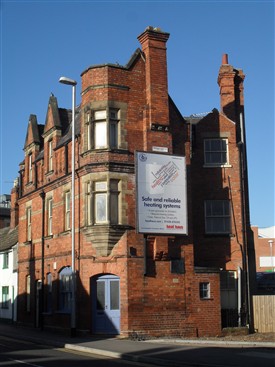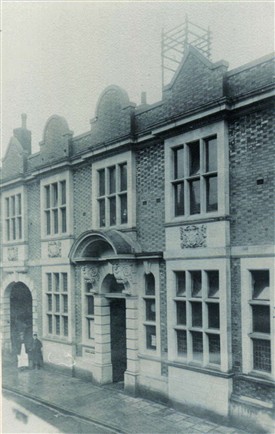The Telephone Exchange - Newark

The National Telephone Company's exchange building on Portland Street
Photographed October 2013

Newark Post Office, Kirkgate, in 1908.
The structure for telephone wires may be seen on the roof.
Town experiences dawn of the first information age
Newarks’s first telephone exchange – built by the National Telephone Company – was opened on Portland Street in 1895. It was some years earlier, however, in 1887, that the first attempt to introduce the telephone to Newark was made.
First Connections
Again, it was the National Telephone Company who made the attempt. In December 1887 they announced that they were about to open an exchange in Lincon which would be connected to Newark on the line from Nottingham.
Unfortunately insufficient subscribers were forthcoming in Newark to warrant an exchange, and it was to be a further six years before Newark became connected to ‘the Victorian information highway’.
In April 1893 and advert appeared in the local press stating that the National Telephone Company were prepared to open an exchange at Newark if they could obtain the necessary 15 subscribers. This time they were successful, and by early 1895 the telephone system was unveiled in the town.
Music ‘broadcasts’ by telephone
It was with much pride that the National Telephone Company announced in the Newark Advertiser newspaper of 22nd may 1895 that its new telephone exchange was ready to go into service.
Among the first subscribers, noted the paper were several large business firms and solicitor’s offices, along with the Newark Advertiser itself, whose number was ‘Newark 11’.
Shortly after the company’s exchange on Portland Street was opened, the manager, Mr J.J. Kinleyside, invited a party to the office where, using they new system, they had “The pleasure of listening to a performance of the Mikado at the Grand Theatre Nottingham, by Mr. D’Oyley Carte’s company”.
Expansion
By 1899 the network in and around Newark had expanded to such an extent that the national Telephone Company opened an exchange at Grantham.
“The network of wires which has been spread over the town indicates that Newark is now brought fully abreast of the times by the introduction of the telephone” (Newark Advertiser 22 May 1895)
This was followed later the same year by another indication that they system was paying its way when it was announced that charges were to be lowered. Annual subscription was £3 3s (plus 7s to be paid in royalty to the government) with a three minute call costing 1d.
Despite such indications of the the company’s success, their control of this new means of communication was soon to be removed.
Enter the GPO
In 1907 responsibility for telephone services throughout the land was transferred to the Post Office, and this coincided in Newark with the building of a new head Post Office in Kirkgate (now The Old Post Office public house).
When this was opened early in 1908 the telephone exchange was transferred to a room on the first floor, with wires radiating across the town from a platform on the roof.
Newark ’s telephone service continued to be administered from Kirkgate until the early 1960s, with rows of telephonists connecting and disconnecting by hand all the town’s outgoing calls.
End of an era
By the mid 1950s it was clear that Newark’s manual exchange was nearing the end of its life. In 1958 plans were drawn up for a new, fully automated exchange to be built behind the tax office (now the job centre) in Lombard Street.
This exchange was opened on 17 May 1962 by the Mayor Councillor R.H. Lamb.
From this date Newark subscribers were able to dial their own calls, not only local but to many parts of the UK, on the new Subscriber Trunk Dialling network.
The Lombard Street exchange was extended in the 1970s, and fully computerised in 1981. As an official press release noted at the time:-
“On Saturday 21st November 1981 at 7.30am the present Electro-mechanical exchange in the Lombard Street building will be replaced by an electronic system (with the exception of numbers beginning with the digit ‘6’ – these will be transferred in 1982)”.